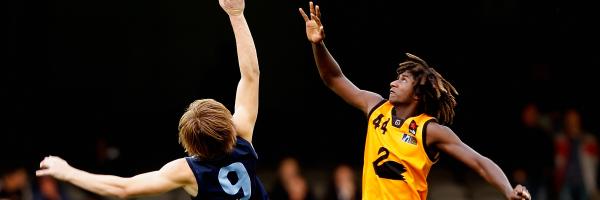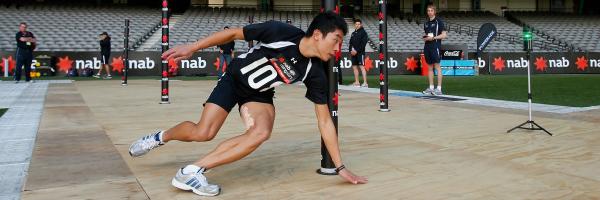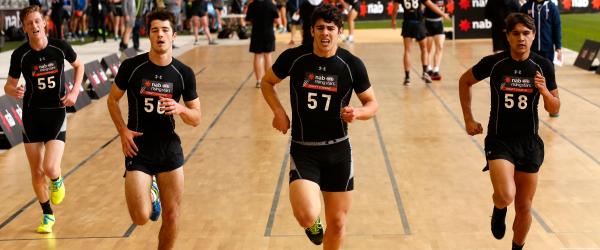Standing vertical jump

It's no surprise that players like Nic Naitanui stand near the top of the rankings in this one. A simple test of footy's spring-heeled, the vertical jump requires players to take off from two feet with no preliminary steps or shuffling. A Yardstick measuring device determines their leap, with the height reached subtracted from the players' standing reach height to give the relative jump result.
| Top Combine performances (cm) | ||
|---|---|---|
| Marvin Baynham | 88 | 2014 |
| Dean Towers | 85 | 2012 |
| Jesse Lonergan | 83 | 2012 |
| Spencer White | 82 | 2012 |
| Eric Wallace | 80 | 2012 |
| Kade Kolodjashnij | 79 | 2013 |
| Nic Naitanui | 78 | 2008 |
| Elliot Yeo | 78 | 2011 |
| Jarrod Garlett | 76 | 2014 |
| Nathan Drummond | 76 | 2014 |
Running vertical jump
We've all tried this one, taking a running leap and trying to go vertical, like a rocket. In this test, a player stands five metres to the side of the measuring apparatus (called a Vertec) and takes a straight-line approach, jumping vertically off his outside leg and reaching as high as possible with the inside hand. The action is similar to what a ruckman attempts to do at a bounce.
The player aims to tap the rotating 'fingers' of the Vertec to the side with his outstretched hand at the maximum height of the jump. He takes three jumps from each side: when he takes off using his left leg he uses his right hand, and vice-versa.
| Top national Combine performances (cm) | ||
|---|---|---|
| Jared Brennan | 102 | 2002 |
| Nic Naitanui | 102 | 2008 |
| Evan Bruinsma | 97 | 2014 |
| Kade Kolodjashnij | 97 | 2013 |
| Marvin Baynham | 95 | 2014 |
| Daniel McKenzie | 94 | 2014 |
| Stephen Hill | 93 | 2008 |
| Brent Renouf | 93 | 2006 |
| Robbie Tarrant | 93 | 2007 |
20-metre sprint
This one's all about speed. The player starts in the 'crouch' or ready position and sprints as fast as possible, making sure he doesn't decelerate before reaching the final gate. Each player is allowed three attempts (with at least two minutes' break between each) and his best times for the 5-, 10- and 20-metre sectors are recorded, regardless of which attempt they were from.
| Top Combine performances (seconds) | ||
|---|---|---|
| Joel Wilkinson | 2.75 | 2010 |
| Jonathan Marsh | 2.78 | 2013 |
| Danyle Pearce | 2.79 | 2004 |
| Ashley Smith | 2.80 | 2008 |
| Marvin Baynham | 2.81 | 2014 |
| Nathan Freeman | 2.82 | 2013 |
| Jack Watts | 2.82 | 2008 |
Agility test

Footy at the elite level requires all sorts of skills but agility is one of most important. In this test, the player starts from an upright position in line with the start gate. The idea is to weave in and out of the poles – without touching or knocking them over – and get to the end of the course as quickly as possible.
A run will be stopped and restarted if the player touches or knocks over any pole. Players run the course three times at maximum effort (with 2-3 minutes recovery between tests). The best of the three times is recorded.
| Top Combine performances (seconds) | ||
|---|---|---|
| Stephen Hill | 7.77 | 2008 |
| Danyle Pearce | 7.79 | 2004 |
| Nathan van Berlo | 7.80 | 2004 |
| Elliot Yeo | 7.80 | 2011 |
| Ahmed Saad | 7.86 | 2011 |
| David Armitage | 7.88 | 2006 |
| Billie Smedts | 7.90 | 2010 |
| Aaron Joseph | 7.91 | 2007 |
6x30m repeat sprint
This test measures speed and endurance, two critical requirements for AFL players. It is usually conducted on a polished wooden floor or on a synthetic indoor track. The players' cumulative times for the six sprints are recorded.
| Top Combine performances (seconds) | ||
|---|---|---|
| Joel Wilkinson | 23.40 | 2010 |
| Brad Harvey | 23.46 | 2010 |
| Shaun Atley | 23.69 | 2010 |
| Kieran Harper | 23.84 | 2010 |
| Jack Fitzpatrick | 23.91 | 2009 |
| Nakia Cockatoo | 23.93 | 2014 |
| Nathan Drummond | 23.95 | 2014 |
| Patrick Dangerfield | 23.96 | 2007 |
| Cyril Rioli | 24.01 | 2007 |
20-metre shuttle run (beep test)

One of the most challenging of the tests, this one has an element of Charles Darwin's theory attached: players are progressively eliminated and only the very fittest reach the upper levels.
The test starts at Level 1, with the final speed known as Level 21 (not yet attained by an AFL prospect).
The idea is for the player to finish each 20-metre leg (running back and forth) before he hears a beep; the test progresses the time between beeps decreases. Judges watch to provide warnings and ultimately signal when players have failed to beat the beep.
| Top Combine performances (level) | ||
|---|---|---|
| Billy Hartung | 16.06 | 2013 |
| Caleb Daniel | 16.01 | 2014 |
| Bradley Hill | 16.01 | 2011 |
| Jack Hiscox | 16.01 | 2014 |
| Will Hoskin-Elliott | 15.12 | 2011 |
| Nathan Drummond | 15.09 | 2014 |
| Tom Sheridan | 15.07 | 2010 |
| Jake Barrett | 15.06 | 2013 |
| Jarrad McVeigh | 15.06 | 2002 |
3km time trial
This one's simple: players get one shot at 3000 metres, usually run around a track (7.5 laps of a 400-metre track is ideal). Testing is generally limited to groups of 10-20, with judges around the track to give runners an indication of laps completed or remaining and elapsed time.
| Top Combine performances (minutes/seconds) | ||
|---|---|---|
| Jack Hiscox | 9.17 | 2014 |
| Josh Kelly | 9.32 | 2013 |
| Tim Houlihan | 9.37 | 2006 |
| Tom Lamb | 9.45 | 2014 |
| Nick Robertson | 9.46 | 2013 |
| Bradley Hill | 9.52 | 2011 |
| Will Hoskin-Elliott | 9.53 | 2011 |
| Alex Neal-Bullen | 9.54 | 2014 |
| Tom Sheridan | 9.57 | 2011 |
| Nathan Drummond | 9.59 | 2014 |
Nathan Buckley kicking test

The test should be conducted on an oval with players wearing football boots.
Each player takes six kicks form various distances and angles. He receives the ball from a caller, who then randomly requests a specific kick (20 metres left or right, 30 metres left or right and 40 metres left or right) be made to a target judge.
The player has 25 seconds to complete the six kicks and is allocated between 1 (for a poor kick) and 5 (excellent) points for each kick.
Matthew Lloyd clean hands test
The test should be conducted on an oval with players wearing football boots. It requires six takes and six handballs and must be completed in a maximum of 35 seconds.
The player takes the ball and then receives a random instruction from a caller; he must then handball (6 metres left or right, 8 metres left or right and 10 metres left or right) to a target. The ball will be kicked to him three times and rolled at him three times. The player must jog back to the starting point after each handball. He is allocated between 1 (for a poor handball) and 5 (excellent) points for each handball.
Brad Johnson goalkicking test
The test should be conducted on an oval with players wearing football boots. Four 'man on the mark' apparatus and goalposts are required. The apparatus are set up at various distances from goal and on specific angles. The player is required to take five kicks for goal: two set shots, a right-foot snap, a left-foot snap and a kick on the run. He must complete the test in a maximum of 50 seconds.
Scoring is based on how many goals and behinds players kick; a goal is only awarded if the ball goes between the two posts and above a 2.5-metre height marker.



